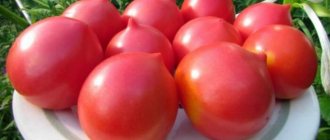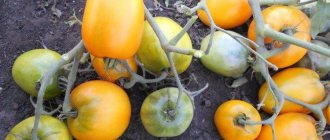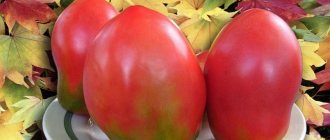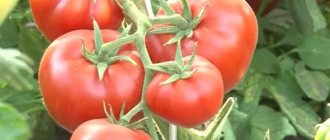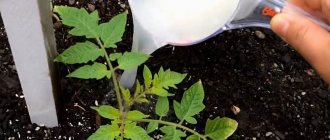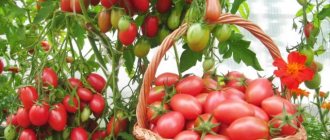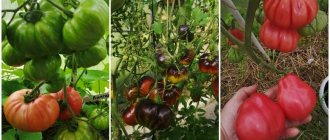Some tomato lovers criticize hybrids, considering them less tasty and healthier than varieties. Others, on the contrary, choose hybrids because they are more productive and less susceptible to various diseases. Every year, new tomato products appear on the shelves of garden centers, most of them are hybrids. Let's look into this tomato story.
- What does a tomato variety and hybrid mean, what is the difference
- What is the advantage of hybrid tomatoes over varieties
- What are the possible disadvantages of growing hybrid tomatoes?
- Classification of tomato hybrids by ripening period
- The best tomato hybrids
- Tomato hybrids for greenhouses
- Tomato hybrids for open ground
- Tomato Hybrid Tarasenko
What does a tomato variety and hybrid mean, what is the difference
A variety is the result of many years of selection and reproduction of the most productive and stable parent pairs of plants. Varietal crops retain their properties in the next several generations. Seeds of any variety can be grown independently; they repeat the parental characteristics. Perhaps this explains the huge (most likely incalculable) popular selection of tomatoes.
On packets of seeds next to the name you can see the designation F1 . This suggests that this is not a variety, but a hybrid form.
The abbreviation is easy to decipher:
F is the first letter of the word children (filii); 1 - first generation.
Hybrids are obtained by crossing specially selected plants of different varieties. An F1 tomato hybrid occurs when you have two tomato plants of different varieties, and then one is pollinated with pollen from the other variety. The seeds of the resulting cross-pollinated tomato will produce plants that are F1 hybrids (first generation hybrid).
The descendants of F1 hybrids are F2. The descendants of F2 are F3 and so on. Hybrids are more productive and of higher quality than varieties, but retain their properties only in the first generation. There is no point in collecting seeds from hybrids. They do not repeat the original qualities, and most often grow up much worse than their parent pairs.
Pink hybrid for greenhouse F1 Donna Rosa (photo: www.udec.ru)
Hybridization requires protected soil and manual labor, so the cost of such seeds is higher than varieties.
To debunk a myth that we sometimes encounter, let us remind you that F1 hybrids are not genetically modified. These are completely natural plants, bred in the traditional way.
Agricultural technology for tomato cultivation
To ensure a high yield, you need to grow healthy seedlings. The variety is cultivated by the most effective method of growing through seedlings. The use of this method involves performing stages of work.
The seed is placed in a container with prepared soil or substrate to a depth of 1.5 cm. Before planting, the soil is moistened with warm water. For the smooth appearance of sprouts, it is important to maintain an optimal air temperature above +21°C.
For normal development of seedlings, it is necessary to provide lighting for 16 hours a day. Watering of plants is carried out as the surface layer of soil dries. It is recommended to add water in the afternoon.
Growing seedlings requires feeding with complex fertilizers containing potassium, nitrogen, and phosphorus. Before planting in the ground, seedlings are hardened for 1 week.
The originator of the variety recommends placing 2.5-2.8 plants per m². Further care of the crop involves timely watering. When cultivating on an industrial scale in closed ground conditions, drip irrigation is organized.
In order to distribute moisture evenly and prevent the growth of weeds, mulching is carried out using fiber and organic materials.
The crop requires fertilizing with complex fertilizers at all stages of development.
To create a moisture balance and provide air access, loosen the soil and hill up the bushes.
What is the advantage of hybrid tomatoes over varieties
By giving preference to hybrid forms of tomatoes, gardeners receive several advantages:
- the tomato yield is many times larger (this phenomenon is well known as hybrid energy);
- ripening time is reduced;
- fruits are one-dimensional, even in shape, color, weight;
- the pulp has a harmonious taste, a rich set of nutrients;
- plants get sick less often, do not suffer much from pests, and adapt well to weather conditions.
Series of tomato hybrids “Great”
Farmer reviews
Gardeners speak mostly positively about the Family variety.
Lyudmila, Kazan: “I’ve been growing this variety for several years.
I like its taste and appearance. It also produces an excellent harvest in our weather conditions. Last year I collected about 6 kg from 1 bush.” Maria, Voronezh region: “I only love hybrids, because they get sick many times less. I planted a family variety for the first time, overall the variety is not bad. The ovary is good, the tomatoes are large. The taste is good."
Elena, Yekaterinburg: “I expected much more from the Family variety. The manufacturer promised large tomatoes, but my maximum weight for one is only 140 g. I grew it according to all the rules, I don’t know what’s wrong.”
What are the possible disadvantages of growing hybrid tomatoes?
When purchasing seeds of a favorite variety, an experienced gardener analyzes its characteristics at the end of the season: early ripeness, yield, taste, color, care features. If everything suits him, he selects high-quality ripe fruits and releases seeds from them. Next year you can use your own seeds. All varietal qualities are preserved.
In the case of F1 hybrids, seeds will have to be purchased annually; it makes no sense to purchase the hybrid form yourself. The second generation may unpleasantly surprise:
- the bushes will be of different heights;
- fruits may vary in color, shape, size;
- low yield;
- if the manufacturer doesn't release a given hybrid for whatever reason, you're stuck. Once the seed is gone, it's gone forever.
tomato F1 Orange Santa
Gardeners' opinion
Good day! For lovers of large-fruited tomatoes, I recommend tomato VP1 f1. The plant is not capricious, shows good yield when cultivated in central Russia. I recommend!
Anna Katya, 34 years old
Good day! This summer I discovered the tomato hybrid VP1 f1. I was pleasantly surprised by the cold resistance of the variety. The plant responds well to feeding and requires staking. The taste of the fruit is excellent. I didn’t find any cons for myself.
Svetlana Prudence, 30 years old
Classification of tomato hybrids by ripening period
When choosing a tomato hybrid, be sure to look at the ripening period. It depends on whether it will have time to form a crop in your strip, and whether or not it is suitable for growing in open ground (in a greenhouse, as a rule, there are no problems, but outside the heat may not be enough). So:
The classification of hybrid tomato seeds is as follows:
early ripening, or so-called early - 85-105 days from germination to the beginning of ripening; mid-early - 106-110 days; mid-season - 111-115 days; medium late - 116-120 days; late ripening - more than 120 days.
Moreover, in different years and in different regions, the growing season of the same variety or hybrid of tomatoes for open ground and greenhouses can be different.
Tomato Fancy characteristics and description of the variety, cultivation and opinion of gardeners with photos
Fenda tomato growing technology
The height of the bushes reaches 2 meters; in greenhouses, growth is unlimited. The growing season of the variety is 70-80 days. The main stem is straight and strong, the leaf blade is quite large, and the rhizome is well developed.
6-10 ovaries are formed on one bunch. A ripe tomato weighs from 250 g to 400 g, the shape of the tomato is round with a pink color. The increased sugar content gives the fruit a sweet taste with a slight sourness. Inside the dense vegetable there are 6 chambers containing seeds. The pulp is fleshy and juicy.
One plant can have 40-50 fruits. Up to 25 kg of tomatoes are harvested from one square. Thanks to its early ripening period, the Fenda variety can be grown twice per season: from spring to summer, from summer to autumn.
- tomatoes are transportable;
- the skin is dense, the fruits do not crack;
- bushes can be grown under film or without it;
- excellent taste and attractive appearance;
- The variety is resistant to many diseases.
- tall bushes require constant garters;
- The variety is demanding on fertilizing.
The indeterminate hybrid prefers greenhouse conditions. It is better to germinate seedlings yourself in early spring. Seeds should be purchased from trusted suppliers, and do not forget to look at the expiration dates on the label. Small and damaged seeds are removed, the rest are dipped in a light manganese solution for 20 minutes, washed and slightly dried.
The seeds are sown in prepared containers, covered with a layer of soil on top and watered. After the sprouts appear (7-10 days), the temperature in the room is reduced to 15 degrees, this is done so that the plant can independently synthesize organic substances from inorganic ones, and also does not grow rapidly.
After a week, the temperature gradually begins to increase until it reaches 22-24 degrees. The container needs to be moved to a lighted place; if there is not enough light, connect daylight lamps. The soil should be moistened 1-2 times every 7 days.
The plants are picked into a separate container when the first leaves appear on the mature seedlings. At the time of transplanting into the garden, the plants reach 25-30 cm in height and have approximately 6-9 leaves. Ovaries are formed every 5 leaves.
A few days before planting seedlings, the soil in the garden should be dug up to a depth of 12-14 cm. Complex fertilizers (NPK-15-20 kg/ha) are applied to the soil. Seedlings are planted in holes in rows according to a pattern of 50 cm by 40 cm, 3-4 bushes are placed per square meter.
Every 4-5 days, moderate watering is done (500 ml of water per plant), water the bushes at the root in the morning until the seedlings take root, the soil moisture should be 80% NV.
Feeding
A rich tomato harvest is achieved with timely feeding. Potassium supplements synthesize vitamin C, increase root growth, and store carbohydrates. Potassium is added during seedling growth, then from the beginning of ovary formation and during fruit ripening.
Phosphorus supplements (superphosphate, precipitate) are necessary for the ripening of fruits and seeds; phosphorus is added twice during the growing season.
Nitrogen gives plants their green color. But an overdose of nitrogen supplements can lead to the development of abundant foliage, and the plant will not have any strength left for the fruits. Nitrogen (ammonium sulfate, manure, urea, ammonium nitrate) is added twice during the growing season: the first time - with the main additives during planting of seedlings, the second time - from the beginning of the formation of ovaries. Since nitrogen fertilizers make the soil acidic, limestone must be added.
Garters
We must not forget to weed weeds, remove dry leaves, and spray bushes to prevent diseases and combat pests.
If tomatoes are cared for incorrectly and poorly, especially if the soil moisture is high, diseases may occur:
Sick plants need to be removed and destroyed to avoid infecting neighboring bushes. Mineral supplements increase the immunity of tomatoes and protect the crop from late blight. Insecticides are used to control pests (cutworm, aphids, Colorado potato beetle).
The best tomato hybrids
Fortunately for us, tomato enthusiasts, today there are many varieties; it is simply impossible to count all the varieties and hybrids. For example, the “Author’s Varieties and Hybrids” series alone includes about 300 items. Available in a rainbow of shades, from red to yellow and purple, in all shapes and sizes, from a tiny cherry to a kilogram giant.
Read about the most interesting yellow tomatoes in this material >>>>>>>
There are special series of hybrids, which include:
- the most delicious tomatoes (“Vkusnoteka”, “Oriental Delicacy” from Search, including hybrids: F1 Coral Reef, F1 Magic Harp, F1 Golden Stream, F1 Chinese Souvenir);
- the most stable (“Special Hybrids” from Biotechnika);
- multi-colored (for example, “Crimson Miracle”);
- compact and for balconies (for example, the “4 summer” series Search);
- especially healthy (usually combines yellow and orange tomatoes);
- a series of tomatoes that do not require pinching (for example, “Nepas”)
- cherry (series “Sweetie”, “Sweets from the garden” SeDek)
Read about how to choose truly black tomatoes here >>>>>
Tomato F1 Sweet million (considered an analogue of F1 Red bunch)
Tomato hybrids for greenhouses
To use the greenhouse productively, try to grow vigorous hybrids (indeterminate). They will grow to the ceiling, which means they will produce more fruit per unit area. Follow the seed manufacturer's recommended planting pattern and do not plant plants too close together.
Tomato F1 Forte Rose (from Semko) pink hybrid: quite early, suitable for greenhouses. May crack in heat.
If you need tomatoes for growing in a greenhouse, suitable for canning , then you can pay attention to the hybrids of the “Tsar” series (SeDek): F1 Empire, F1 Empress, F1 Russian Empire, F1 Peter the Great, F1 Peter the Great. They are tall and set fruit well even in low light conditions or in conditions of temperature changes. The tomatoes of these hybrids are perfectly preserved both on the bush and during storage.
Tomato series F1 Russian Empire and F1 Peter the Great
Fruitful salad-type giants for the greenhouse are included in the “Great Tomatoes” (SeDek) series: F1 Alexander the Great, F1 Vladimir the Great, F1 Catherine the Great, F1 Dmitry the Great. They are distinguished by their large size, rich taste, resistance to tobacco mosaic virus, verticillium and fusarium wilt, cladosporiosis and other diseases; high stress resistance.
For the southern regions and high greenhouses the series of cherry tomatoes “Octopus” (SeDek) has gained particular popularity, these are the so-called tomato trees: F1 Octopus cream raspberry, F1 Octopus cream orange, F1 Octopus cream chocolate, F1 Octopus cherry raspberry, F1 Octopus cherry . All of them are incredibly productive and resistant to many tomato diseases.
F1 Opera is one of the earliest ripening hybrids for greenhouses. Plant height is 1.5 m. The fruits are round, even, smooth, weighing 100–110 g. Thanks to the pronounced tomato aroma and harmonious taste, they are especially good fresh, but are also suitable for canning. The variety is very productive – 5–5.5 kg, maximum – 8.5 kg. Resistant to many diseases.
Cherry tomato hybrids occupy leading positions :
F1 Strawberry Indeterminate hybrid of cherry tomato with a beautiful and original heart-shaped or “strawberry” fruit shape. The tomatoes are collected in elegant, even clusters of 18–30 pieces.
F1 Miracle Bunch Hybrid is characterized by high growth energy, bears fruit until autumn and is resistant to a range of diseases and various weather stresses. The first fruits are ready for harvest after 90–95 days.
F1 Blue bunch Indeterminate mid-season cherry tomato hybrid with fruits that play in the sun with all shades of blue and blue!
Cherry tomatoes
Planting in the ground and caring for tomatoes
Ready seedlings, which will have at least 5-7 true leaves, are planted in a prepared greenhouse or in beds.
For the Carpal hybrid, a placement pattern of 0.4 m in a row and 0.7 m in row spacing is suitable. This area is enough for the normal life of plants.
Tomatoes are formed into 1-2 stems. To do this, either all the stepsons are removed, or the lowest one is left. A second stem is formed from it. The first inflorescence appears on the bush after 9-11 leaves, the next ones after it - after 3 leaves. 6-7 fruits of equal size are tied to 1 cluster.
The Carpal hybrid is tall, so it cannot do without a garter to supports, a trellis or a net. They are installed when planting seedlings.
The brushes need to be tied up if there is a possibility that they will not support the weight of the fruit. But usually this is not required.
Like all tomatoes, Kistevoy needs abundant watering and timely feeding. Only with careful care will you be able to get a good harvest.
For watering in a greenhouse, you can use a drip irrigation system; this is convenient in terms of saving water, time and labor for the gardener. Using the system, you can also fertilize along with watering - just dilute a certain amount of fertilizer in water.
To preserve soil moisture, you need to use mulch from plant material or agrofibre. If there is no shelter, the soil is loosened every time after watering.
Feeding is carried out at least three times per season. The first - when the tomatoes begin to throw out flowers, the second - during mass flowering, the third and, if necessary, the fourth - at intervals of 2 weeks.
Both mineral mixtures and organic matter are used. How much fertilizer to take and in what volume to dilute is indicated in the instructions for each drug.
When using organic matter, slurry diluted with water in a ratio of 1 to 10 is poured under each bush, 1 liter. Then water the tomatoes with clean water.
During 2-4 feedings, phosphorus and potassium fertilizers can be replaced with ordinary ash from burnt plant debris - scatter it under the bushes at the rate of 0.5 kg per 1 sq. m. m or water the plants with ash solution (1 tbsp per bucket).
Hybrid Carpal tomatoes begin to sing 3 months after germination. The fruits turn red together, usually they are all evenly colored, so when removing the berries, they pick off the entire cluster of fruit at once.
The shelf life of tomatoes (in bunches) is 3-4 weeks after harvesting, which is a very good indicator for early tomatoes.
Tomato hybrids for open ground
When choosing tomato hybrids for open ground in the Middle Zone, give preference to early and mid-early ones. The standard type of growth has the advantage; determinant ones are also suitable. and of course, for open ground it is vital that the tomato is resistant to late blight, a sinister disease of nightshades. It won’t hurt if the manufacturer promises that the hybrid is capable of ripening if the bush is harvested prematurely (such as F1 Caspar 2, F1 Torbay).
Lovers of sugar and meaty tomatoes will appreciate a series of beef tomatoes suitable for growing in open ground and film greenhouses: F1 Openwork, F1 Barin, F1 Bourgeois, F1 Fat, F1 Doll, F1 Doll Dasha, F1 Doll Masha, F1 Gift for a Woman. These are beef tomato hybrids with determinate type plants.
Tomato F1 Openwork
Hybrid F1 Red Red for open ground is attractive for its versatility, resistance to diseases and temperature changes. Can be grown in a greenhouse and in open ground. Plant height is up to 150 cm, branching is average. At the same time, the bush itself looks quite powerful due to its single strong stem. Clusters with large fruits of 5-7 pieces are formed on it. The weight of one tomato is from 200 to 500 g, manufacturers promise up to 8 kg of fruit per bush. The pulp is sweet, loose, sugary. Fruits for fresh consumption, salads and canning in the form of lecho, adjika, tomato sauce.
Read about how to properly form tomatoes here >>>>>>>
Advantages and disadvantages of the variety
The hybrid Carpal F1 has many advantages, which is why vegetable growers are happy to choose it for their plots. First of all, this is productivity, their rapid ripening, and a long shelf life (for early tomatoes).
Tomatoes have an excellent appearance - the fruits are red, almost the same size, transport well, and do not crack.
The bushes are resistant to diseases, lack of light and heat, which makes it possible to grow them in cold regions. Plants tolerate bad weather well.
With proper care, in heated greenhouses, the hybrid can produce at least 2 harvests per season.
No disadvantages were found in the variety, except that you need to buy seeds every year, since they are hybrid.
Tomato Hybrid Tarasenko
This is where the confusion begins. The fact is that tomatoes under this name are not hybrids at all, but varieties! Moreover, they are quite interesting and popular, such as Hybrid Tarasenko, Yubileiny, Tomato Tarasenko. They were brought out by an amateur vegetable grower from the Sumy region, Feodosiy Tarasenko, a physics teacher who was fond of gardening. His track record includes about 50 varieties of tomatoes.
- How to avoid confusion and choose the right hybrid specifically for your conditions, read our convincing guide to choosing tomato varieties and hybrids.
- You can learn more about how F1 hybrids are made from our article >>>>>>
- Read all about growing tomatoes (tomatoes) in our selection of materials here >>>>>>>>>>
Photo for article: sugar series of tomatoes from SeDek company
Diseases and pests
With high humidity, tomatoes may suffer from late blight . To avoid the disease, it is necessary to carry out preventive treatment with Profit Gold or Barrier. As a preventive measure against ticks or aphids, a single treatment at the beginning of the growing season with the insecticides Zubr, Tanrek, and Confidor works well.
"Premium F1" is a rather unpretentious variety. It does not require constant attention, grows well in any soil, does not suffer from most diseases, and is productive. Well suited for beginner gardeners.
In the table below you will find links to informational articles about tomato varieties with different ripening periods:
| Super early | Early ripening | Mid-early |
| Big Mama | Samara | Torbay |
| Ultra early ripening f1 | Early love | Golden King |
| Mystery | Apples in the snow | King London |
| White filling | Apparently invisible | Pink Bush |
| Alenka | Earthly love | Flamingo |
| Moscow stars f1 | My love f1 | Mystery of nature |
| Debut | Crimson Giant | New Koenigsberg |
